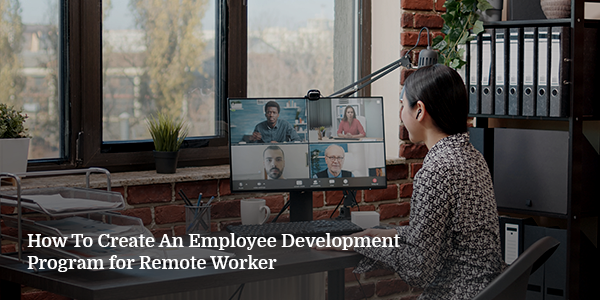
A good work environment should allow employees to enhance their abilities and grow with the organization. Having a transparent and fair career development plan helps employees learn new skills and progress in their careers.
Apart from unlocking skills your organization can use to its advantage, employees who have a clear goal to strive for are generally more engaged at work and less likely to leave prematurely
Remote employees need this, too, as they can feel isolated and disengaged when not properly managed. Instead of constantly finding new employees with the necessary skill sets, why not train your remote workers through various courses to make them more competent?
This article will guide you in creating an effective employee development program for remote workers.
What is an Employee Development Program?
An employee development program (EDP) facilitates your staff’s career improvement and success. From onboarding to training, an EDP helps hone your employees’ skills, equips them with the necessary competencies to progress in their career paths, and allows the organization address its skills gap.
A career development program can also help employees stay driven, feel involved with the company, and perform better. This is especially important for remote workers who often feel isolated and disengaged when left to their own devices.
Implementing an EDP for remote workers may be challenging because monitoring and tracking their progress is harder due to the lack of physical contact. There may also be distractions within the training, difficulties in collaborating and communication, and a chance of being passive.
Hence, here are a few guidelines for creating an EDP tailored to remote workers.
7 Steps to Create an Employee Development Program for Remote Workers
-
Start with a training needs analysis
The first step to creating an EDP is knowing what needs to be addressed. A training needs analysis will reveal the competencies your employees need to function effectively in their roles or the role they want in the future. It also exposes the technical skills your organization needs to fill immediately.
To perform a training needs analysis, you must first define your desired outcome. After that, identify and evaluate the trainable competencies you want your employees to improve. Once you’ve determined these gaps, determine how best to execute your training program.
-
Talk with your employees about their career paths
Communicating will help you gather insights from your employees and a deeper understanding of the data you’ve analyzed from your organization’s training needs. You can share the potential you see in them, what can be done to unlock them, and how those benefit them as employees and the company. Employees can also voice out their aspirations.
It is important to have an open communication line instead of making assumptions about your employees’ skills and goals, especially when dealing with remote workers.
-
Identify high-potential employees to put through the program
Although an EDP applies to all employees, special training programs may be appropriate for specific individuals. For instance, if you notice an employee with innate leadership ability, you can put them through a leadership training program to better hone their skills before you give them a promotion.
Identifying high-potential employees is crucial to maximizing the talent and skill pool already available to you. Being proactive in searching for these high-potential employees is vital as they are harder to spot in a remote setting.
-
Consider which approach to take
When implementing your program, you can choose from different learning approaches depending on the person or the situation. You can implement your EDP through cross-training, coaching and mentoring, classroom training, performance management, and 360-degree feedback. Remember that you can experiment with each approach if you find one lacking or ineffective.
For example, a remote worker may learn best through one-on-one coaching since this is a more engaging style. It can reduce stagnation and the feeling of detachment, which are common in a remote setting. However, more independent learners may choose asynchronous learning to better match their pace or if it is the only option when dealing with remote workers from different time zones.
-
Know which KPIs to track
Key performance indicators (KPIs) are specific and measurable metrics used to analyze a program’s effectiveness. Some useful KPIs to monitor are training participation rate, training cost per employee, and learner satisfaction.
-
Establish systems for providing feedback
A part of healthy communication in the workspace is providing feedback. Employees should receive comments and advice about their performance from their supervisors.
Before or after completing an EDP or achieving goals, it is helpful for managers to sit down with their employees to discuss their strengths, weaknesses, and points for improvement. This should also work the other way around—the trainee should voice their feedback regarding the training methods and their efficacy so that everyone is on the same page.
-
Implement and monitor
Executing an EDP is not the final step. It is crucial to keep an eye on it after implementation. Hold regular check-ins to see each trainee’s progress, areas for improvement, the setbacks that can be mitigated, and suggestions for better outcomes. It would also help remote workers choose a convenient schedule for their training program.
Employees’ Growth = Company’s Expansion
An employee development program goes beyond advancement as it also broadens the organization. Besides establishing and enhancing the skills of your employees, it solidifies the company’s outcomes.
If you need help hiring high-potential remote employees, contact Manila Recruitment. As one of the leading recruitment agencies in the Philippines, Manila Recruitment’s team of experts can help you find and recruit suitable employees that will grow with your business.













